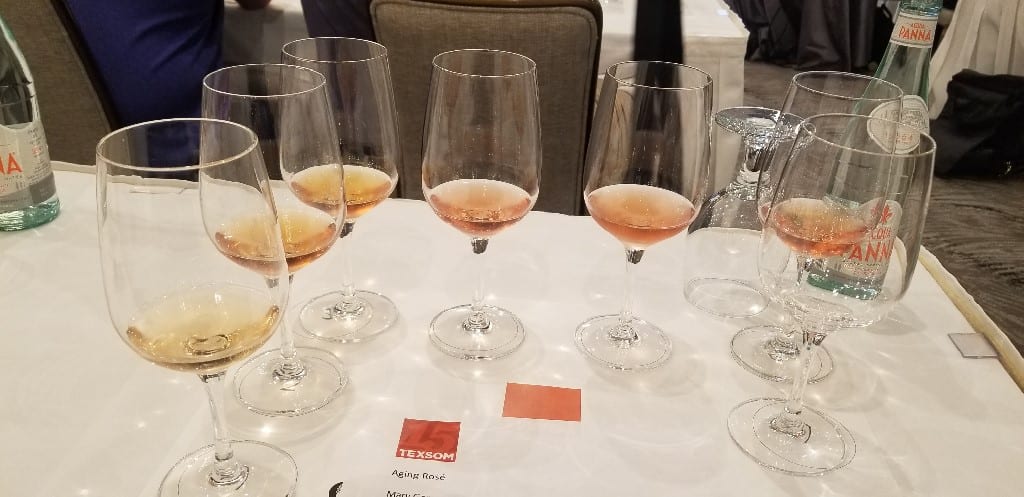
01 Oct Can We Age Our Rosés?
Each year, wineries release their rosés and we, the consumer, can’t get enough. We drink our rosé wine year round now but typically we buy the wine and consume it rather quickly. But what if we find a rosé is our collection that is a year, or two or more, years old? What if we forgot about it. Can we drink it now? Can rosé age? This is something I have wondered as I have found a few rosés in my home that are not from the current vintage. Luckily this was a topic covered at TEXSOM this year and I wrote about it in the Napa Valley Register which you can read here.
Summer is coming to an end but drinking rosé has not stopped. I have found myself picking up a few more bottles of rosé from here and there as I travel around to wine regions. I come home and add the new bottles of rosé to my wine list and start to plan when to drink them.
But what I realized is that I still have a few bottles of rosé in my collection from last year and the year before and likely the year before that. How did that happen? How do I have rosé wine that I did not drink already? What do I do now? If the wine is a year old, I am fine. But what about a rosé with two, three, four or more years of age on it. Is it still drinkable? Can we age our rosés?
I recently wrote a story about Gerard Bertrand who has released his new rosé Clos de Temple, which he made with the intention to age for at least 10 years. But for me, I have been struggling with this question. Will the rosés I have at home age well or should I throw them out if I don’t drink them within a year or two?
Luckily this was a topic tackled at TexSom in August. Masters of Wine Mary Gorman and Sheri Morano led a discussion and tasting, in which we explored the aging of rosé including opportunities and challenges, purpose and necessity, and which rosé wines are made to age.
Let’s start with a look back at the recent past of rosé. Once popular pale “red” wines were seen more as “failed” red wines as darker colored wines became more popular. A lack of proper equipment made consistent rosés harder to produce. Many critics were dismissive of pink wines. And there was the rise of White Zinfandel. But since 2010, rosé wine sales have grown exponentially, and winemakers cannot seem to make enough and we cannot drink enough.
But what are we expecting when we sip one of these pink-hued wines? Do you expect the wine to be a pale pink color? Do you expect it to be fruity, easy-drinking, young and not serious? Or do you expect something more? If you want to age your rosés, even just a little bit, there are some things to consider.
Typically, a wine that can age has firm structure, acidity, complexity, length/persistence, fruit definition, balance, alcohol, depth of fruit and flavor and texture. Other considerations are the grape variety, the vineyard the wine comes from, the vintage, the cellar and the wine itself (its color, structure and fruit). We look for high tannins and anthocyanins, a core of flavor and acidity in a red wine that has aging potential.
We look for high acidity, low-ish pH and high flavor intensity in a white wine we want to age. High natural sugar, botrytis and fortification are also markers for a wine with aging potential. So what about rosé?
Beginning with the vineyard, we want to consider the soil and pH, the grape variety, the vine age and the specific vintage. There is also the harvest method – what is the level of ripeness when the grapes are picked? Were they picked by hand or machine? What are the yields?
Once the grapes are in the cellar, there are more considerations. What is the method of production – skin contact, saignée or blending red and white wines? What is the length of skin contact? What is the fermentation vessel and temperature? What yeasts are used? Does the wine spend time on the lees, does it go through malolactic fermentation and how is it aged?
There are a lot of things to consider, and these are decisions for the winemaker. What we, the drinker, should be looking for is a rosé with firm structure, high acidity, complexity and a long finish.
The wine should have moderate alcohol, texture, balance and tannin. There are some known rosé producers who are currently aging their wines before they release them:
Biondi Santi Tenute Greppo Rosato di Toscana is aged 18 months before release as is the Valentini Montepulciano Cerasuolo d’Abruzzo Rosato, which also spends some time in cask before release. Chateau Simone Palette Rosé spends a full year in large oak foudres and Lopez de Heredia Vina Tondonia Rose Gran Reserva is aged for four years with racking occurring twice a year. And another rosé wine that spends time aging before release, and which we can also hold for a couple years, is a Rosé Champagne.
So, should we age our rosé wines? Can we age them? Will they improve with age? Some rosés cannot and aging is not a requirement of this category. But because of better winemaking and the emergence of “gastronomic” rosé wine, some can. I sure hope a few of the rosés I have held on to have aged well and will just have to open them up to see.
Read the original story in the Napa Valley Register.
Discover more from Please The Palate
Subscribe to get the latest posts sent to your email.



